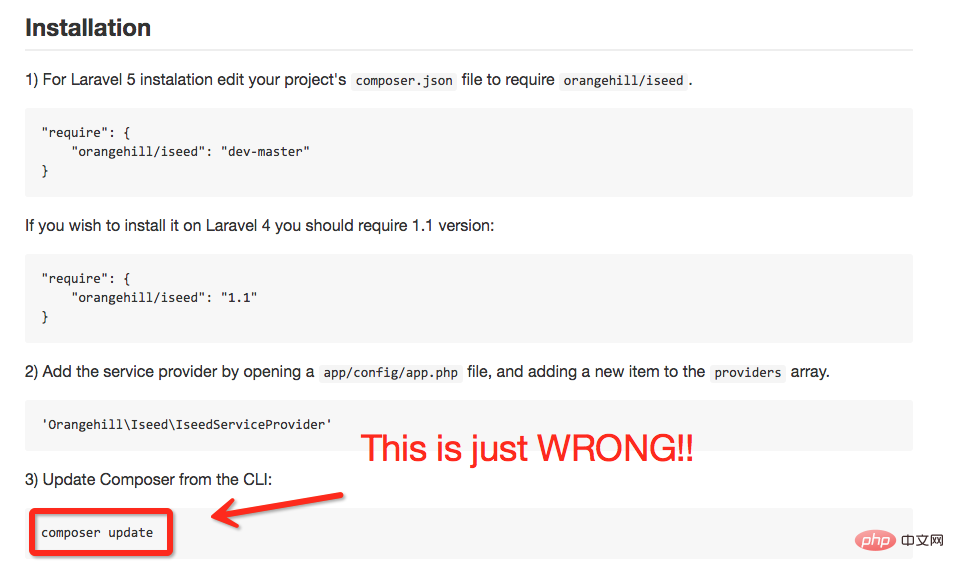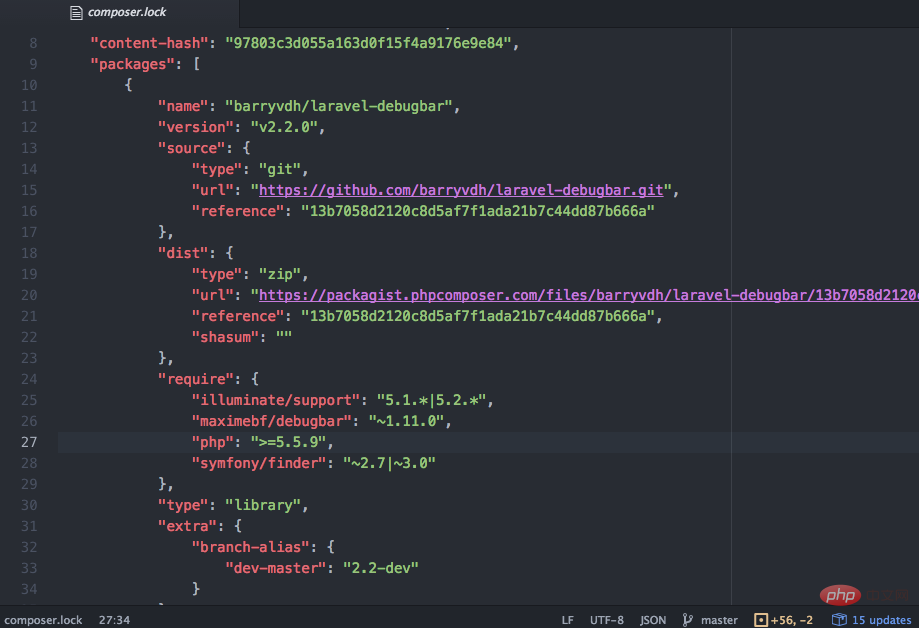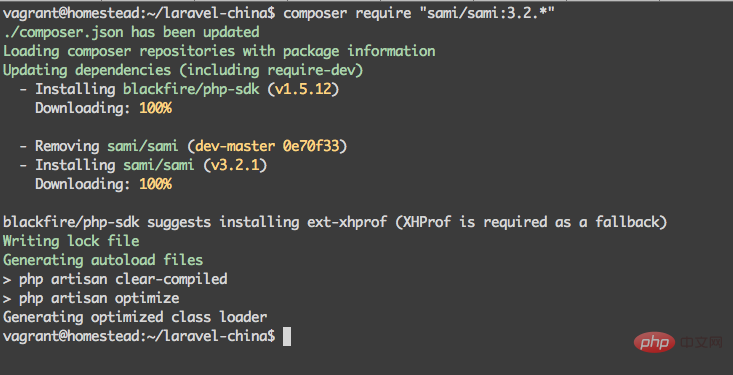Use composer update with caution!
The following tutorial column of composer will introduce to you the issues about using composer update with caution. I hope it will be helpful to friends in need!

Problem Description
We often need to add extension packages to existing projects , sometimes due to incorrect guidance in the document, as the following picture comes from this document:

composer update This command may cause great harm to the project in our current logic.
Because the logic of composer update is to update all expansion packages to the latest version according to the expansion package version rules specified by composer.json. Note, it is all expansion packages. For example, when you start the project Monolog was used. The configuration information at that time was
"monolog/monolog": "1.*",
. The monolog 1.1 version was installed. But now, more than a month later, monolog is already 1.2. After running the command, it is directly updated to 1.2. At this time, the project does not After testing against 1.2, the project suddenly became very unstable. The situation is sometimes worse than this, especially in a huge project where you have not written complete coverage tests for the project. Something broke for you. Do not know at all.
Which command should be used? install, update or require?
Next we will explain one by one.
Simple explanation
composer install - 如有 composer.lock 文件,直接安装,否则从 composer.json 安装最新扩展包和依赖; composer update - 从 composer.json 安装最新扩展包和依赖; composer update vendor/package - 从 composer.json 或者对应包的配置,并更新到最新; composer require new/package - 添加安装 new/package, 可以指定版本,如: composer require new/package ~2.5.
Process
Let’s introduce a few Daily production process to facilitate and deepen everyone’s understanding.
Process 1: New project process
Create composer.json and add the extension package it depends on;
Run composer install, install the extension package and generate composer.lock;
Submit composer. lock to the code version controller, such as: git;
Process 2: Project collaborators install existing projects
After cloning the project, run composer install directly in the root directory to install the specified version from composer.lock The extension package and its dependencies;
This process is suitable for the deployment of production environment code.
Process 3: Add a new extension package to the project
Use composer require vendor/package to add the extension package;
Submit the updated composer.json and composer.lock to the code In the version controller, such as: git;
About the composer.lock Use composer update with caution!
The composer.lock Use composer update with caution! stores the dependencies of each code The version record (see figure below) is submitted to the version controller and used in conjunction with composer install to ensure the consistency of the code versions running in the development environment and online production environment of all collaborators in the team.

关于扩展包的安装方法
那么,准备添加一个扩展包,install, update, require 三个命令都可以用来安装扩展包,选择哪一个才是正确的呢?
答案是:使用 composer require 命令
另外,在手动修改 composer.json 添加扩展包后,composer update new/package 进行指定扩展包更新的方式,也可以正确的安装,不过不建议使用这种方法,因为,一旦你忘记敲定后面的扩展包名,就会进入万劫不复的状态,别给自己留坑呀。
上面的概念不论对新手或者老手来说,都比较混淆,主要记住这个概念:
原有项目新添加扩展的,都使用 composer require new/package 这种方式来安装。
需要加版本的话
composer require "foo/bar:1.0.0"
更新指定扩展到指定版本
有时候你之前使用过的扩展包,加入了新功能,你想更新单独这个扩展包到指定版本,也可以使用 require 来操作。
如下面例子,需要更新 “sami/sami”: “3.0.” 到 “sami/sami”: “3.2.” 
命令行运行: 
The above is the detailed content of Use composer update with caution!. For more information, please follow other related articles on the PHP Chinese website!

Hot AI Tools

Undresser.AI Undress
AI-powered app for creating realistic nude photos

AI Clothes Remover
Online AI tool for removing clothes from photos.

Undress AI Tool
Undress images for free

Clothoff.io
AI clothes remover

Video Face Swap
Swap faces in any video effortlessly with our completely free AI face swap tool!

Hot Article

Hot Tools

Notepad++7.3.1
Easy-to-use and free code editor

SublimeText3 Chinese version
Chinese version, very easy to use

Zend Studio 13.0.1
Powerful PHP integrated development environment

Dreamweaver CS6
Visual web development tools

SublimeText3 Mac version
God-level code editing software (SublimeText3)

Hot Topics
 Use Composer to solve the dilemma of recommendation systems: andres-montanez/recommendations-bundle
Apr 18, 2025 am 11:48 AM
Use Composer to solve the dilemma of recommendation systems: andres-montanez/recommendations-bundle
Apr 18, 2025 am 11:48 AM
When developing an e-commerce website, I encountered a difficult problem: how to provide users with personalized product recommendations. Initially, I tried some simple recommendation algorithms, but the results were not ideal, and user satisfaction was also affected. In order to improve the accuracy and efficiency of the recommendation system, I decided to adopt a more professional solution. Finally, I installed andres-montanez/recommendations-bundle through Composer, which not only solved my problem, but also greatly improved the performance of the recommendation system. You can learn composer through the following address:
 Laravel Introduction Example
Apr 18, 2025 pm 12:45 PM
Laravel Introduction Example
Apr 18, 2025 pm 12:45 PM
Laravel is a PHP framework for easy building of web applications. It provides a range of powerful features including: Installation: Install the Laravel CLI globally with Composer and create applications in the project directory. Routing: Define the relationship between the URL and the handler in routes/web.php. View: Create a view in resources/views to render the application's interface. Database Integration: Provides out-of-the-box integration with databases such as MySQL and uses migration to create and modify tables. Model and Controller: The model represents the database entity and the controller processes HTTP requests.
 Solve caching issues in Craft CMS: Using wiejeben/craft-laravel-mix plug-in
Apr 18, 2025 am 09:24 AM
Solve caching issues in Craft CMS: Using wiejeben/craft-laravel-mix plug-in
Apr 18, 2025 am 09:24 AM
When developing websites using CraftCMS, you often encounter resource file caching problems, especially when you frequently update CSS and JavaScript files, old versions of files may still be cached by the browser, causing users to not see the latest changes in time. This problem not only affects the user experience, but also increases the difficulty of development and debugging. Recently, I encountered similar troubles in my project, and after some exploration, I found the plugin wiejeben/craft-laravel-mix, which perfectly solved my caching problem.
 Laravel framework installation method
Apr 18, 2025 pm 12:54 PM
Laravel framework installation method
Apr 18, 2025 pm 12:54 PM
Article summary: This article provides detailed step-by-step instructions to guide readers on how to easily install the Laravel framework. Laravel is a powerful PHP framework that speeds up the development process of web applications. This tutorial covers the installation process from system requirements to configuring databases and setting up routing. By following these steps, readers can quickly and efficiently lay a solid foundation for their Laravel project.
 How to view the version number of laravel? How to view the version number of laravel
Apr 18, 2025 pm 01:00 PM
How to view the version number of laravel? How to view the version number of laravel
Apr 18, 2025 pm 01:00 PM
The Laravel framework has built-in methods to easily view its version number to meet the different needs of developers. This article will explore these methods, including using the Composer command line tool, accessing .env files, or obtaining version information through PHP code. These methods are essential for maintaining and managing versioning of Laravel applications.
 How to simplify email marketing with Composer: DUWA.io's application practices
Apr 18, 2025 am 11:27 AM
How to simplify email marketing with Composer: DUWA.io's application practices
Apr 18, 2025 am 11:27 AM
I'm having a tricky problem when doing a mail marketing campaign: how to efficiently create and send mail in HTML format. The traditional approach is to write code manually and send emails using an SMTP server, but this is not only time consuming, but also error-prone. After trying multiple solutions, I discovered DUWA.io, a simple and easy-to-use RESTAPI that helps me create and send HTML mail quickly. To further simplify the development process, I decided to use Composer to install and manage DUWA.io's PHP library - captaindoe/duwa.
 Using Dicr/Yii2-Google to integrate Google API in YII2
Apr 18, 2025 am 11:54 AM
Using Dicr/Yii2-Google to integrate Google API in YII2
Apr 18, 2025 am 11:54 AM
VprocesserazrabotkiveB-enclosed, Мнепришлостольностьсясзадачейтерациигооглапидляпапакробоглесхетсigootrive. LEAVALLYSUMBALLANCEFRIABLANCEFAUMDOPTOMATIFICATION, ČtookazaLovnetakProsto, Kakaožidal.Posenesko
 laravel installation code
Apr 18, 2025 pm 12:30 PM
laravel installation code
Apr 18, 2025 pm 12:30 PM
To install Laravel, follow these steps in sequence: Install Composer (for macOS/Linux and Windows) Install Laravel Installer Create a new project Start Service Access Application (URL: http://127.0.0.1:8000) Set up the database connection (if required)






